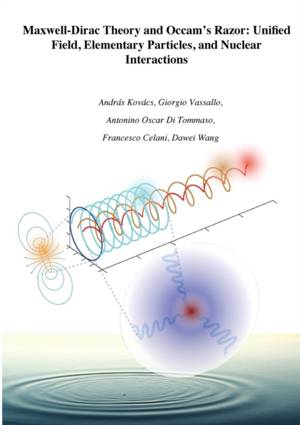
- Retrait gratuit dans votre magasin Club
- 7.000.000 titres dans notre catalogue
- Payer en toute sécurité
- Toujours un magasin près de chez vous
- Retrait gratuit dans votre magasin Club
- 7.000.0000 titres dans notre catalogue
- Payer en toute sécurité
- Toujours un magasin près de chez vous
Maxwell-Dirac Theory and Occam's Razor
Unified Field, Elementary Particles, and Nuclear Interactions
András Kovács, Giorgio Vassallo, Francesco CelaniDescription
We introduce and use the space-time Clifford algebra, showing that only one fundamental physical entity is sufficient to describe the origin of electromagnetic fields, charges and currents: the electromagnetic four-potential. This simplified electromagnetic model turns out to be an improved understanding of electromagnetism. The obtained electromagnetic Lagrangian is the simplest possible relativistic Lagrangian formulation. Quantum mechanical relations follow naturally from this model, and we derive the electromagnetic formulation of the Dirac equation. The spinor field is shown to correspond to electromagnetic energy-momentum, and the complex-valued probability density is shown to correspond to electromagnetic Lagrangian density. This initial part of the book completes the theory initiated by Maxwell and Dirac.
The structure and dynamics of the electron are described next, showing how its mass originates from the electromagnetic field energy and showing how mass varies relativistically. Using this model, we derive the charge quantization mechanism. This part fulfills Einstein's wish for understanding the electron before attempting to understand more complex particles. Through the study of electron dynamics, a more elaborate understanding of the Heisenberg uncertainty principle is developed, which is indispensable for understanding nuclear interactions.
The book concludes by showing how the same model can be applied to describe nuclear forces and nucleons, and a very large set of "anomalous" or unexplained experimental data suddenly make sense.
Spécifications
Parties prenantes
- Auteur(s) :
- Editeur:
Contenu
- Nombre de pages :
- 150
- Langue:
- Anglais
Caractéristiques
- EAN:
- 9789529420926
- Date de parution :
- 01-07-19
- Format:
- Livre broché
- Format numérique:
- Trade paperback (VS)
- Dimensions :
- 210 mm x 297 mm
- Poids :
- 376 g

Les avis
Nous publions uniquement les avis qui respectent les conditions requises. Consultez nos conditions pour les avis.






